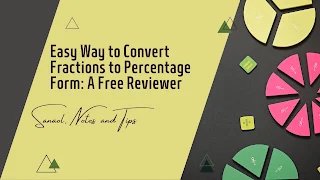What's in this article?
A. Steps on how to convert a fraction to its percentage form.
B. Detailed Guide and Quick Tricks.
C. Reviewer with detailed solutions.
It is one of the topics in Business Mathematics. If you can still remember, we were taught how to do it even in elementary days. If you forgot it already, don't worry because this reviewer explains the process in a straightforward way. So whether you are having an advanced study on this topic or preparing for a quiz, exam, or preparing for the Civil Service exam, this reviewer is well-crafted and explained for you.
You may opt to read Mastering the Conversion of Fractions to Decimals: A Detailed Reviewer first for an easier process. Anyway, you may still proceed to read this guide directly.
There are three steps used in this guide to convert fractions into decimal forms. These steps are as follows:
Step 1. Divide the numerator by the denominator.
Step 2. Multiply the resulting amount by 100.
Step 3. Add the % symbol.
Let us apply these steps to the following examples:
Convert 1/2 to decimal form.
Step 1. Divide the numerator by the denominator.
1 ÷ 2
Step 2. Multiply the resulting amount by 100.
0.50 x 100
Step 3. Add the % symbol.
It will become: 50%
Convert 3/10 to decimal form.
=3 ÷ 10
=0.30 x 100
=30%
Alternatively, you may use this Quick Trick:
Notice that the denominator is 10. Take note of this; it has one zero, right? Just add that zero next to the numerator including the % symbol afterwards.
Here, take a look:
1/10 = 10%
2/10 = 20%
3/10 = 30%
4/10 = 40%
5/10 = 50%
6/10 = 60%
7/10 = 70%
8/10 = 80%
9/10 = 90%
10/10 = 100%
Did you see the pattern? It's amazing right? But here's a note: the quick tip given only works with the above fractions.
Let's say the denominator is 100. Converting fractions (with 100 as the denominator) into percentage form is much easier because all you have to do is attach the % symbol after the numerator. Take a look at the following examples:
3/100 = 3%
12/100 = 12%
49/100 = 49%
85/100 = 85%
99/100 = 99%
and so on.
For fractions ending in 1,000, just move the decimal point one space to the left. For example, 85/1000. It will be 8.5%.
For fractions ending in 10,000, just move the decimal point two spaces to the left. For example, 165/10000. It will be 1.65%.
and so on.
For more complex fractions such as 67/125, what you can do to simplify it is to do these steps.
Step 1: Identify the next 'power of 10' that is close to the denominator.
It's 1000, right?
Step 2: Divide it by the denominator.
We know that when we divide 1000 by 125, we will get eight right?
Step 3: Multiply the resulting number to the numerator.
8 x 67 = 536
Step 4: Move the decimal point one space to the left.
Since the fraction becomes 536/1000, use the previous trick where you will just need to move the numerator's decimal point one step to the left.
So from 536, it will become 53.6. Just add the % symbol and it will become 53.6%.
This sounds confusing? If that's the case, the best method to use is the first one, which is dividing the numerator by the denominator. After which, multiply the resulting number by 100. Then add the % symbol.
Convert 35/160 to decimal form.
= 35 ÷ 160
= 0.21875 x 100
= 21.875%
Convert 18/64 to decimal form.
= 18 ÷ 64
= 0.28125 x 100
= 28.125%
There you have it-the possible ways you can convert a fraction to a percentage form. Hopefully, you learned something from this blog. Should you have any concerns or clarifications, feel free to ask by leaving a comment. If you want to master it more, just download the reviewer at the end of this post.
Remember, you don't need to become an expert in Mathematics just for you to understand this topic. A little effort can go a long way already. So, start with the basic concepts which are presented above, and as you keep on practicing them, you'll notice a sense of accomplishment. Don't be afraid. Instead, turn that fear into strength. It may be slow, but you will also master this topic soon.
Have you enjoyed this tutorial? Do not forget to follow our page for more updates and tutorials soon. Again, mastery is the key. Have a great day!

